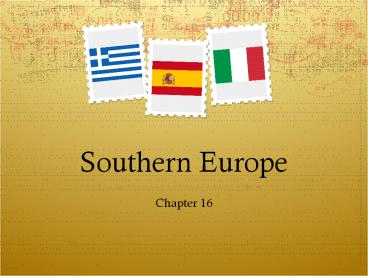Southern Europe - PowerPoint PPT Presentation
1 / 26
Title:
Southern Europe
Description:
Southern Europe Chapter 16 Iberian Peninsula Analyze how past events have affected Spain. Compare and contrast Portugal and Spain. What countries are located on the ... – PowerPoint PPT presentation
Number of Views:96
Avg rating:3.0/5.0
Title: Southern Europe
1
Southern Europe
- Chapter 16
2
Iberian Peninsula
- ?Analyze how past events have affected Spain.
- ?Compare and contrast Portugal and Spain.
3
What countries are located on the Iberian
Peninsula?
- Spain and Portugal
4
What did the Moors bring to Iberia in the 700s?
- Islamic religion
- New irrigation techniques
- Crafts
- New crops
- Universities
- Trade
5
List historical facts about Spain
- 700s ? Moors invade and start to rule
- 1492 ? Moors are driven out by the Christians
from Rome, converting everyone to Roman
Catholicism which is the main religion today. - 1500s ? Spain has many over seas territories,
due to a strong navy - 1800s ? lost most of its territories, due to
wars - 1939 ? terrible civil war, democracy vs.
dictatorship, Francisco Franco wins. - 1975 ? Franco dies, return to democracy, 17
regions with different levels of autonomy, self
governing, while still having a central
government - Currently have a constitutional monarchy
6
How far is Spain from Africa?
- 8 miles
7
What is the most common feature of Spain's
villages and cities?
- Plazas- or large open areas in the center of
town, usually in front of the church
8
What activities play a major role in the Spanish
economy?
- Manufacturing
- Textiles, clothing, footwear, ships, cars, etc
- Tourism
- Costa del Sol, Pyrenees, Balearic Is.
- Agriculture
- Olive oil, wine, oranges, corn, potatoes, tomatoes
9
Where was Portugals Empire?
- Africa, Asia, South America
10
Italian Peninsula
- ?Analyze how Italys history has affected its
culture. - ?Describe what Italy is like today.
- What shape does that look like?
11
List important facts about Rome.
- 1st city to hold 1 million people
- Center of the Roman Empire
- Capital of Italy
- Vatican City located inside, it is a completely
independent country
12
Give details about Italy
- Northern part became rich from trade
- Even though the Alps separate it from the rest of
Europe, it was the center of the Renaissance,
which was a period from 1300s to 1500s marked by
a renewed interest in learning in Europe. - Italy was not a united country until 1861
- Member of the European Union and NATO
13
What is the most famous part of Italian culture?
- Food
- It is not anything you see on the Jersey Shore
14
Why is Rome important to Italy?
- Political Cultural Center
- Capital city
- Largest city
- Money from Tourism
- Historical city
15
Roman History
16
Greece and the Balkan Peninsula
- ?Analyze how Greece developed into a modern
country - .?Explain why the western Balkans are politically
unstable. - ?Describe the changes that are occurring in the
eastern Balkans.
17
Trace the history of government in Greece.
- City-States which was the start of democracy.
- Roman Ottoman Turks controlled parts of Greece
- 1829 Greece becomes and independent country
- Many elected governments followed a Civil War,
but military leaders took over in 1967 - 1974 return to democratic government
18
Greece has a large island named Crete
19
What challenges does Greece have today?
- Still a poor country, even though it is a member
of the European Union, the Olympics being held in
Athens (capital) has helped. - Immigrants from Albania taking jobs
- Urbanizing quickly, which has led to many urban
problems (smog, traffic, pollution)
20
Which countries make up the Western Balkans?
- Albania (Europes poorest country)
- Bosnia (Herzegovina)
- Croatia
- Macedonia
- Slovenia
- Serbia
- Montenegro
- Serbia Montenegro used to be combined to make
Yugoslavia
21
Discuss the governments of the Western Balkans
- Controlled by the Ottoman Turks
- World War I most of the countries won
independence from the Ottoman Empire - Yugoslavia formed to unite Slavic people, after
World War I, Albania has remained independent
since 1912 - World War II USSR occupied Balkans except for
Greece, with was ruled by a dictator named Tito - 1980-1990 Yugoslavia starts to split up
- 1991 Slovenia Croatia declare independence
- 1992 Bosnia declares independence, Albania
changes to democratic government
22
What are some causes for economic challenges in
the West Balkan countries?
- War
- Corruption with in the government
- Lack of industry with in the countries
23
What countries make up the Eastern Balkans?
- Bulgaria/Romania/ Moldova
24
Trace the Eastern Balkans road to independence.
- Historically controlled by the Romans,
Byzantines, and Ottoman Turks - Gained independence from the Ottomans after their
empire collapsed at the end of World War I
- During and after World War II, their were
controlled by the USSR - Gained independence after the the fall of
communism in 1990.
25
What are contributors to Eastern Balkan
underdeveloped economy?
- Lack of Housing
- Lack of Health Care
- Lack of Jobs
26
Define
- Enclave
- Cork (Portugal is the worlds leading producer)
- City-States
- Microstates
- Areas that are completely surrounded by another
region. - Bark that is stripped from the trunks of cork
oaks. - Self-governing cities and their surrounding
areas, as in ancient Greece. - Very small countries, such as Andorra, Monaco,
and San Marino































